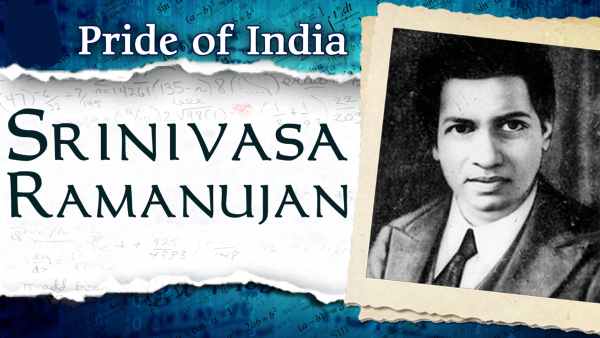भारतीय गणितज्ञ श्रीनिवास रामानुजन का जन्म 22 दिसंबर, 1887 में मद्रास, भारत में हुआ था। सोफी जर्मिन की तरह, उन्हें गणित में कोई औपचारिक शिक्षा नहीं मिली लेकिन उन्होंने गणित के उन्नयन में महत्वपूर्ण योगदान दिया।
गणित में उनका मुख्य योगदान मुख्य रूप से विश्लेषण, गेम सिद्धांत और अनंत श्रृंखला में है।
उन्होंने प्रकाश और नए उपन्यास विचारों को लाकर विभिन्न गणितीय समस्याओं को हल करने के लिए गहराई से विश्लेषण किया, जिसने गेम सिद्धांत की प्रगति को बढ़ावा दिया।
इस दिन पर बहुत से स्कूल एवं विश्विद्यालय में essay और speech compatition होता है|
Srinivasa ramanujan par nibandh
इस दिन quotes अपने व्हाट्सप्प स्टेटस पर लगा सकते है| या व्हाट्सप्प पर wishes सेंड कर सकते है|
Srinivasa Ramanujan – श्रीनिवास रामानुजन् इयंगर एक महान भारतीय गणितज्ञ थे। उन्हें आधुनिक काल के महानतम गणित विचारकों में गिना जाता है। उन्हें गणित में कोई विशेष प्रशिक्षण नहीं मिला, फिर भी उन्होंने विश्लेषण एवं संख्या सिद्धांत के क्षेत्रों में महत्वपूर्ण योगदान दिये। उन्होंने गणित के क्षेत्र में कई महत्वपूर्ण प्रयोग किये थे जो आज भी उपयोग किये जाते है। उनके प्रयोगों को उस समय जल्द ही भारतीय गणितज्ञो ने मान्यता दे दी थी।
जब उनका हुनर ज्यादातर गणितज्ञो के समुदाय को दिखाई देने लगा। तब उन्होंने इंग्लिश गणितज्ञ जी.एच्. हार्डी से भागीदारी कर ली। उन्होंने पुराने प्रचलित थ्योरम की पुनः खोज की ताकि उसमे कुछ बदलाव करके नया थ्योरम बना सके।
श्रीनिवास रामानुजन / Srinivasa Ramanujan ज्यादा उम्र तक तो जी नही पाये लेकिन अपने छोटे जीवन में ही उन्होंने लगभग 3900 के आस-पास प्रमेयों का संकलन कीया। इनमें से अधिकांश प्रमेय सही सिद्ध किये जा चुके है। और उनके अधिकांश प्रमेय लोग जानते है। उनके बहोत से परीणाम जैसे की रामानुजन प्राइम और रामानुजन थीटा बहोत प्रसिद्ध है। यह उनके महत्वपूर्ण प्रमेयों में से एक है।
उनके काम को उन्होंने उनके अंतर्राष्ट्रीय प्रकाशन रामानुजन जर्नल में भी प्रकाशित किया है। ताकि उनके गणित प्रयोगों को सारी दुनिया जान सके और पूरी दुनिया में उनका उपयोग हो सके। उनका यह अंतर्राष्ट्रीय प्रकाशन पुरे विश्व में प्रसिद्ध हो गया था। और काफी लोग गणित के क्षेत्र में उनके अतुल्य योगदान से प्रभावित भी हुए थे।
श्रीनिवास रामानुजन का प्रारंभिक जीवन / Srinivasa Ramanujan Biography in Hindi
श्रीनिवास रामानुजन / Srinivasa Ramanujan का जन्म 22 दिसम्बर 1887 को भारत के दक्षिणी भूभाग में स्थित कोयंबटूर के ईरोड, मद्रास (अभी का तमिलनाडु) नाम के गांव में हुआ था। वह पारंपरिक ब्राह्मण परिवार में जन्मे थे। उनके पिता श्रीनिवास अय्यंगर जिले की ही एक साडी की दुकान में क्लर्क थे। उनकी माता, कोमल तम्मल एक गृहिणी थी और साथ ही स्थानिक मंदिर की गायिका थी। वह अपने परीवार के साथ कुम्भकोणम गाव में सारंगपाणी स्ट्रीट के पास अपने पुराने घर में रहते थे।
उनका परीवारीक घर आज एक म्यूजियम है। जब रामानुजन देड (1/5) साल के थे, तभी उनकी माता ने एक और बेटे सदगोपन को जन्म दिया, जिसका बाद में तीन महीनो के भीतर ही देहांत हो गया।
दिसंबर 1889 में, रामानुजन को चेचक की बीमारी हो गयी। इस बीमारी से पिछले एक साल में उनके जिले के हजारो लोग मारे गए थे। लेकिन रामानुजन जल्द ही इस बीमारी से ठीक हो गये थे। इसके बाद वे अपने माता के साथ मद्रास (चेन्नई) के पास के गाव कांचीपुरम में माता-पिता के घर में रहने चले गए।
नवंबर 1891 और फीर 1894 में, उनकी माता ने दो और बच्चों को जन्म दिया। लेकिन फिर से उनके दोनों बच्चो की बचपन में ही मृत्यु हो गयी।
1 अक्टूबर 1892 को श्रीनिवास रामानुजन / Srinivasa Ramanujan को स्थानिक स्कूल में डाला गया। मार्च 1894 में, उन्हें तामील मीडियम स्कूल में डाला गया।
उनके नाना के कांचीपुरम के कोर्ट में कर रहे जॉब को खो देने के बाद, रामानुजन और उनकी माता कुम्भकोणम गाव वापिस आ गयी और उन्होंने रामानुजन को कंगयां प्राइमरी स्कूल में डाला। जब उनके दादा का देहांत हुआ, तो रामानुजन को उनके नाना के पास भेज दिया गया। जो बाद में मद्रास में रहने लगे थे।
रामानुजन को मद्रास में स्कूल जाना पसन्द नही था, इसीलिए वे ज्यादातर स्कूल नही जाते थे। उनके परिवार ने रामानुजन के लिये एक चौकीदार भी रखा था ताकि रामानुजन रोज स्कूल जा सके। और इस तरह 6 महीने के भीतर ही रामानुजन कुम्भकोणम वापिस आ गये। जब ज्यादातर समय रामानुजन के पिता काम में व्यस्त रहते थे। तब उनकी माँ उनकी बहोत अच्छे से देखभाल करती थी।
रामानुजन को अपनी माता से काफी लगाव था। अपनी माँ से रामानुजन ने प्राचीन परम्पराओ और पुराणों के बारे में सीखा था। उन्होंने बहोत से धार्मिक भजनों को गाना भी सीख लिया था ताकि वे आसानी से मंदिर में कभी-कभी गा सके। ब्राह्मण होने की वजह से ये सब उनके परीवार का ही एक भाग था। कंगयां प्राइमरी स्कूल में, रामानुजन एक होनहार छात्र थे।
बस 10 साल की आयु से पहले, नवंबर 1897 में, उन्होंने इंग्लिश, तमिल, भूगोल और गणित की प्राइमरी परीक्षा उत्तीर्ण की और पुरे जिले में उनका पहला स्थान आया। उसी साल, रामानुजन शहर की उच्च माध्यमिक स्कूल में गये जहा पहली बार उन्होंने गणित का अभ्यास कीया।
Srinivasa Ramanujan Childhood:
11 वर्ष की आयु से ही श्रीनिवास रामानुजन / Srinivasa Ramanujan अपने ही घर पर किराये से रह रहे दो विद्यार्थियो से गणित का अभ्यास करना शुरू कीया था। बाद में उन्होंने एस.एल. लोनी द्वारा लिखित एडवांस ट्रिग्नोमेट्री का अभ्यास कीया।
13 साल की अल्पायु में ही वे उस किताब के मास्टर बन चुके थे और उन्होंने खुद कई सारे थ्योरम की खोज की। 14 वर्ष की आयु में उन्हें अपने योगदान के लिये मेरिट सर्टिफिकेट भी दिया गया और साथ ही अपनी स्कूल शिक्षा पुरी करने के लिए कई सारे अकादमिक पुरस्कार भी दिए गए और सांभर तंत्र की स्कूल में उन्हें 1200 विद्यार्थी और 35 शिक्षको के साथ प्रवेश दिया गया।
गणित की परीक्षा उन्होंने दिए गए समय से आधे समय में ही पूरी कर ली थी। और उनके उत्तरो से ऐसा लग रहा था जैसे ज्योमेट्री और अनंत सीरीज से उनका घरेलु सम्बन्ध हो।
रामानुजन ने 1902 में घनाकार समीकरणों को आसानी से हल करने के उपाय भी बताये और बाद में क्वार्टीक (Quartic) को हल करने की अपनी विधि बनाने में लग गए। उसी साल उन्होंने जाना की क्विन्टिक (Quintic) को रेडिकल्स (Radicals) की सहायता से हल नही किया जा सकता।
Essay about srinivasa ramanujan

Srinivasa Ramanujan was one of India’s greatest mathematical geniuses. He made substantial contributions to the analytical theory of numbers and worked on elliptic functions, continued fractions, and infinite series.
Ramanujan was born in his grandmother’s house in Erode, a small village about 400 km southwest of Madras. When Ramanujan was a year old his mother took him to the town of Kumbakonam, about 160 km nearer Madras. His father worked in Kumbakonam as a clerk in a cloth merchant’s shop. In December 1889 he contracted smallpox.
When he was nearly five years old, Ramanujan entered the primary school in Kumbakonam although he would attend several different primary schools before entering the Town High School in Kumbakonam in January 1898. At the Town High School, Ramanujan was to do well in all his school subjects and showed himself an able all round scholar. In 1900 he began to work on his own on mathematics summing geometric and arithmetic series.
Ramanujan was shown how to solve cubic equations in 1902 and he went on to find his own method to solve the quartic. The following year, not knowing that the quintic could not be solved by radicals, he tried (and of course failed) to solve the quintic.
It was in the Town High School that Ramanujan came across a mathematics book by G S Carr called Synopsis of elementary results in pure mathematics. This book, with its very concise style, allowed Ramanujan to teach himself mathematics, but the style of the book was to have a rather unfortunate effect on the way Ramanujan was later to write down mathematics since it provided the only model that he had of written mathematical arguments. The book contained theorems, formulae and short proofs. It also contained an index to papers on pure mathematics which had been published in the European Journals of Learned Societies during the first half of the 19th century. The book, published in 1856, was of course well out of date by the time Ramanujan used it.
By 1904 Ramanujan had begun to undertake deep research. He investigated the series ∑(1/n) and calculated Euler’s constant to 15 decimal places. He began to study the Bernoulli numbers, although this was entirely his own independent discovery.
Ramanujan, on the strength of his good school work, was given a scholarship to the Government College in Kumbakonam which he entered in 1904. However the following year his scholarship was not renewed because Ramanujan devoted more and more of his time to mathematics and neglected his other subjects. Without money he was soon in difficulties and, without telling his parents, he ran away to the town of Vizagapatnam about 650 km north of Madras. He continued his mathematical work, however, and at this time he worked on hypergeometric series and investigated relations between integrals and series. He was to discover later that he had been studying elliptic functions.
In 1906 Ramanujan went to Madras where he entered Pachaiyappa’s College. His aim was to pass the First Arts examination which would allow him to be admitted to the University of Madras. He attended lectures at Pachaiyappa’s College but became ill after three months study. He took the First Arts examination after having left the course. He passed in mathematics but failed all his other subjects and therefore failed the examination. This meant that he could not enter the University of Madras. In the following years he worked on mathematics developing his own ideas without any help and without any real idea of the then current research topics other than that provided by Carr’s book.
Continuing his mathematical work Ramanujan studied continued fractions and divergent series in 1908. At this stage he became seriously ill again and underwent an operation in April 1909 after which he took him some considerable time to recover. He married on 14 July 1909 when his mother arranged for him to marry a ten year old girl S Janaki Ammal. Ramanujan did not live with his wife, however, until she was twelve years old.
Ramanujan continued to develop his mathematical ideas and began to pose problems and solve problems in the Journal of the Indian Mathematical Society. He devoloped relations between elliptic modular equations in 1910. After publication of a brilliant research paper on Bernoulli numbers in 1911 in the Journal of the Indian Mathematical Society he gained recognition for his work. Despite his lack of a university education, he was becoming well known in the Madras area as a mathematical genius.
In 1911 Ramanujan approached the founder of the Indian Mathematical Society for advice on a job. After this he was appointed to his first job, a temporary post in the Accountant General’s Office in Madras. It was then suggested that he approach Ramachandra Rao who was a Collector at Nellore. Ramachandra Rao was a founder member of the Indian Mathematical Society who had helped start the mathematics library. He writes in [30]:-
A short uncouth figure, stout, unshaven, not over clean, with one conspicuous feature-shining eyes- walked in with a frayed notebook under his arm. He was miserably poor. … He opened his book and began to explain some of his discoveries. I saw quite at once that there was something out of the way; but my knowledge did not permit me to judge whether he talked sense or nonsense. … I asked him what he wanted. He said he wanted a pittance to live on so that he might pursue his researches.
श्रीनिवास रामानुजन निबंध
जन्म: 22 दिसम्बर 1887
मृत्यु: 26 अप्रैल 1920
कार्यक्षेत्र: गणित
उपलब्धियां: लैंडॉ-रामानुजन् स्थिरांक, रामानुजन्-सोल्डनर स्थिरांक, रामानुजन् थीटा फलन, रॉजर्स-रामानुजन् तत्समक, रामानुजन् अभाज्य, कृत्रिम थीटा फलन, रामानुजन् योग
दुनिया में कभी-कभी ऐसी विलक्षण प्रतिभाएं जन्म लेती हैं जिनके बारे में जानकार सभी आश्चर्य चकित रह जाते हैं। महान गणितग्य श्रीनिवास अयंगर रामानुजन एक ऐसी ही भारतीय प्रतिभा का नाम है जिनपर न केवल भारत को परन्तु पूरे विश्व को गर्व है। महज 33 वर्ष की उम्र में शायद ही किसी वैज्ञानिक और गणितग्य ने इतना कुछ किया हो जितना रामानुजन ने किया। यह आश्चर्य की ही बात है कि किसी भी तरह की औपचारिक शिक्षा न लेने के बावजूद उन्होंने उच्च गणित के क्षेत्र में ऐसी विलक्षण खोजें कीं जिससे इस क्षेत्र में उनका नाम हमेशा के लिए अमर हो गया। ये न केवल भारत बल्कि समूचे विश्व का दुर्भाग्य था कि गणित का ये साधक मात्र तैंतीस वर्ष की आयु में तपेदिक के कारण परलोक सिधार गया।
रामानुजन बचपन से ही विलक्षण प्रतिभा के धनी थे। आपको ये जानकार हैरानी होगी कि इन्होंने स्वयं गणित सीखा और अपने चिर जीवनकाल में गणित के 3,884 प्रमेयों का संकलन किया। उनके द्वारा दिए गए अधिकांश प्रमेय गणितज्ञों द्वारा सही सिद्ध किये जा चुके हैं। उन्होंने अपने प्रतिभा के बल पर बहुत से गणित के क्षेत्र में बहुत से मौलिक और अपारम्परिक परिणाम निकाले जिनपर आज भी शोध हो रहा है। हाल ही में रामानुजन के गणित सूत्रों को क्रिस्टल-विज्ञान में प्रयुक्त किया गया। इनके कार्य से प्रभावित गणित के क्षेत्रों में हो रहे काम के लिये और इस महान गणितग्य को सम्मानित करने के लिए रामानुजन जर्नल की स्थापना भी की गई है।
प्रारंभिक जीवन
श्रीनिवास अयंगर रामानुजन का जन्म 22 दिसम्बर 1887 को तमिल नाडु के कोयंबटूर के ईरोड नामक गांव में एक पारंपरिक ब्राह्मण परिवार में हुआ था। इनके पिता का नाम श्रीनिवास अय्यंगर और माता का नाम कोमलताम्मल था। जब बालक रामानुजन एक वर्ष के थे तभी उनका परिवार कुंभकोणम में आकर बस गया था। इनके पिता एक स्थानिय व्यापारी के पास मुनीम का कार्य करते थे। शुरू में बालक रामानुजन का बौद्धिक विकास दूसरे सामान्य बालकों जैसा नहीं था और वह तीन वर्ष की आयु तक बोलना भी नहीं सीख पाए थे, जिससे उनके माता-पिता को चिंता होने लगी। जब बालक रामानुजन पाँच वर्ष के थे तब उनका दाखिला कुंभकोणम के प्राथमिक विद्यालय में करा दिया गया।
पारंपरिक शिक्षा में रामानुजन का मन कभी भी नहीं लगा और वो ज्यादातर समय गणित की पढाई में ही बिताते थे। आगे चलकर उन्होंने दस वर्ष की आयु में प्राइमरी परीक्षा में पूरे जिले में सर्वोच्च अंक प्राप्त किया और आगे की शिक्षा के लिए टाउन हाईस्कूल गए।
रामानुजन बड़े ही सौम्य और मधुर व्यवहार के व्यक्ति थे। वह इतने सौम्य थे कि कोई इनसे नाराज हो ही नहीं सकता था। धीरे-धीरे इनकी प्रतिभा ने विद्यार्थियों और शिक्षकों पर अपना छाप छोड़ना शुरू कर दिया। वह गणित में इतने मेधावी थे कि स्कूल के समय में ही कॉलेज स्तर का गणित पढ़ लिया था। हाईस्कूल की परीक्षा में इन्हें गणित और अंग्रेजी मे अच्छे अंक लाने के कारण छात्रवृत्ति मिली जिससे कॉलेज की शिक्षा का रास्ता आसान हो गया।
उनके अत्यधिक गणित प्रेम ने ही उनकी शिक्षा में बाधा डाला। दरअसल, उनका गणित-प्रेम इतना बढ़ गया था कि उन्होंने दूसरे विषयों को पढना छोड़ दिया। दूसरे विषयों की कक्षाओं में भी वह गणित पढ़ते थे और प्रश्नों को हल किया करते थे। इसका परिणाम यह हुआ कि कक्षा 11वीं की परीक्षा में वे गणित को छोड़ बाकी सभी विषयों में अनुत्तीर्ण हो गए जिसके कारण उनको मिलने वाली छात्रवृत्ति बंद हो गई। उनके परिवार की आर्थिक स्थिति पहले से ही ठीक नहीं थी और छात्रवृत्ति बंद होने के कारण कठिनाईयां और बढ़ गयीं। यह दौर उनके लिए मुश्किलों भरा था।
घर की आर्थिक स्थिति सुधारने के लिए रामानुजन ने गणित के ट्यूशन और कुछ एकाउंट्स का काम किया। वर्ष 1907 में उन्होंने बारहवीं कक्षा की प्राइवेट परीक्षा दी लेकिन इस बार भी वह अनुत्तीर्ण हो गए। इस असफलता के साथ उनकी पारंपरिक शिक्षा भी समाप्त हो गई।
संघर्ष का समय
बारहवीं कक्षा की प्राइवेट परीक्षा में अनुत्तीर्ण होने के बाद के कुछ वर्ष उनके लिए बहुत हताशा और गरीबी भरे थे। इस दौरान रामानुजन के पास न कोई नौकरी थी और न ही किसी संस्थान अथवा प्रोफेसर के साथ काम करने का अवसर। इन विपरीत परिस्थितियों में भी रामानुजन ने गणित से सम्बंधित अपना शोध जारी रखा। गणित के ट्यूशन से महीने में कुल पांच रूपये मिलते थे और इसी में गुजारा करना पड़ता था। यह समय उनके लिए बहुत कष्ट और दुःख से भरा था। उन्हें अपने भरण-पोषण और गणित की शिक्षा को जारी रखने के लिए इधर उधर भटकना पड़ा और लोगों से सहायता की मिन्नतें भी करनी पड़ी।
इधर रामानुजन बेरोजगारी और गरीबी से जूझ ही रहे थे कि उनकी माता ने इनका विवाह जानकी नामक कन्या से कर दिया। आर्थिक तंगी और पत्नी की बढ़ी जिम्मेदारी को पूरा करने के लिए वे नौकरी की तलाश में मद्रास चले गए। चूँकि उन्होंने बारहवीं की परीक्षा उत्तीर्ण नहीं की थी इसलिए इन्हें नौकरी नहीं मिल पा रही थी और इसी बीच उनका स्वास्थ्य भी बुरी तरह खराब हो गया जिसके कारण वापस कुंभकोणम लौटना पड़ा। स्वास्थ्य ठीक होने के बाद वे दोबारा मद्रास गए और कुछ संघर्षों के बाद वहां के डिप्टी कलेक्टर श्री वी. रामास्वामी अय्यर से मिले जो गणित के बड़े विद्वान थे। अय्यर ने उनकी दुर्लभ प्रतिभा को पहचाना और अपने जिलाधिकारी रामचंद्र राव से कह कर इनके लिए 25 रूपये मासिक छात्रवृत्ति का प्रबंध करा दिया। 25 रूपये की इस छात्रवृत्ति पर रामानुजन ने मद्रास में एक साल रहते हुए अपना प्रथम शोधपत्र “जर्नल ऑफ इंडियन मैथेमेटिकल सोसाइटी” में प्रकाशित किया। इसका शीर्षक था “बरनौली संख्याओं के कुछ गुण”। राव की सहायता से उन्होंने मद्रास पोर्ट ट्रस्ट में क्लर्क की नौकरी कर ली। इस नौकरी में उन्हें गणित के लिए पर्याप्त समय मिल जाता था।
essay in english
आप ये जानकारी हिंदी, इंग्लिश, मराठी, बांग्ला, गुजराती, तमिल, तेलगु, आदि की जानकारी देंगे जिसे आप अपने स्कूल के निबंध प्रतियोगिता, कार्यक्रम या निबंध प्रतियोगिता में प्रयोग कर सकते है| ये निबंध कक्षा 1, 2, 3, 4, 5, 6, 7, 8, 9 ,10, 11, 12 और कॉलेज के विद्यार्थियों के लिए दिए गए है|
Srinivasa Ramanujan, (born December 22, 1887, Erode, India—died April 26, 1920, Kumbakonam), Indian mathematician whose contributions to the theory of numbers include pioneering discoveries of the properties of the partition function.
When he was 15 years old, he obtained a copy of George Shoobridge Carr’s Synopsis of Elementary Results in Pure and Applied Mathematics, 2 vol. (1880–86). This collection of thousands of theorems, many presented with only the briefest of proofs and with no material newer than 1860, aroused his genius. Having verified the results in Carr’s book, Ramanujan went beyond it, developing his own theorems and ideas. In 1903 he secured a scholarship to the University of Madras but lost it the following year because he neglected all other studies in pursuit of mathematics.
Ramanujan continued his work, without employment and living in the poorest circumstances. After marrying in 1909 he began a search for permanent employment that culminated in an interview with a government official, Ramachandra Rao. Impressed by Ramanujan’s mathematical prowess, Rao supported his research for a time, but Ramanujan, unwilling to exist on charity, obtained a clerical post with the Madras Port Trust.
In 1911 Ramanujan published the first of his papers in the Journal of the Indian Mathematical Society. His genius slowly gained recognition, and in 1913 he began a correspondence with the British mathematician Godfrey H. Hardy that led to a special scholarship from the University of Madras and a grant from Trinity College, Cambridge. Overcoming his religious objections, Ramanujan traveled to England in 1914, where Hardy tutored him and collaborated with him in some research.
Ramanujan’s knowledge of mathematics (most of which he had worked out for himself) was startling. Although he was almost completely unaware of modern developments in mathematics, his mastery of continued fractions was unequaled by any living mathematician. He worked out the Riemann series, the elliptic integrals, hypergeometric series, the functional equations of the zeta function, and his own theory of divergent series. On the other hand, he knew nothing of doubly periodic functions, the classical theory of quadratic forms, or Cauchy’s theorem, and he had only the most nebulous idea of what constitutes a mathematical proof. Though brilliant, many of his theorems on the theory of prime numbers were wrong.
In England Ramanujan made further advances, especially in the partition of numbers (the number of ways that a positive integer can be expressed as the sum of positive integers; e.g., 4 can be expressed as 4, 3 + 1, 2 + 2, 2 + 1 + 1, and 1 + 1 + 1 + 1). His papers were published in English and European journals, and in 1918 he was elected to the Royal Society of London. In 1917 Ramanujan had contracted tuberculosis, but his condition improved sufficiently for him to return to India in 1919. He died the following year, generally unknown to the world at large but recognized by mathematicians as a phenomenal genius, without peer since Leonhard Euler (1707–83) and Carl Jacobi (1804–51). Ramanujan left behind three notebooks and a sheaf of pages (also called the “lost notebook”) containing many unpublished results that mathematicians continued to verify long after his death.
Essay in tamil
ऊपर हमने आपको srinivasa ramanujan essay biography, essay on srinivasa ramanujan in hindi, srinivasa ramanujan essay in english, s r ramanujan, आदि की जानकारी किसी भी भाषा जैसे Hindi, Urdu, उर्दू, English, sanskrit, Tamil, Telugu, Marathi, Punjabi, Gujarati, Malayalam, Nepali, Kannada के Language Font में साल 2007, 2008, 2009, 2010, 2011, 2012, 2013, 2014, 2015, 2016, 2017 का full collection whatsapp, facebook (fb) व instagram पर share कर सकते हैं|
ஸ்ரீனிவாச ராமானுஜன் (இந்தியாவின் ஈரோடு, டிசம்பர் 22, 1887, இறந்தார் ஏப்ரல் 26, 1920, கும்பகோணம்) இந்திய கணிதவியலாளர்கள் எண்களின் கோட்பாட்டின் பங்களிப்பாளர்களாக உள்ளனர்.
அவர் 15 வயதாக இருந்தபோது, ஜார்ஜ் ஷோவிரிட்ஜ் கார் இன் சஸ்பொபிஸ் ஆஃப் எலிமெண்டரி எஃபெக்ட்ஸ் இன் தூய அண்ட் அப்ளைடு கணிதத்தில், 2 தொகுதி. (1880-86). ஆயிரக்கணக்கான கோட்பாடுகளின் தொகுப்புகள், 1860 க்கும் மேலாக எந்தவொரு புதிய ஆதாரமும் இல்லாமல், அவற்றின் பலத்தை மட்டுமே அளித்த பலர் அவருடைய மேதைமையை தூண்டிவிட்டனர். காரியின் புத்தகத்தில் முடிவுகளை சரிபார்த்து, ராமானுஜன் அதைத் தாண்டி சென்று தனது சொந்த கோட்பாடுகளையும் கருத்துக்களையும் வளர்த்துக் கொண்டார். 1903 ஆம் ஆண்டில் அவர் மெட்ராஸ் பல்கலைக் கழகத்தில் ஸ்காலர்ஷிப்பைப் பெற்றார், ஆனால் அடுத்த ஆண்டு அதை கணிதத்தில் முனைப்புடன் நடத்தினார்.
ராமானுஜன் தனது வேலையைத் தொடர்ந்தார், வேலை இல்லாமல், மிக மோசமான சூழ்நிலைகளில் வாழ்ந்தார். 1909-ல் திருமணம் செய்துகொண்ட பிறகு, நிரந்தர வேலைவாய்ப்புக்காகத் தேட ஆரம்பித்தார், அது அரசாங்க அதிகாரி ராமச்சந்திர ராவுடன் ஒரு பேட்டியில் முடிந்தது. ராமானுஜன் கணித ரீதியிலான ஆர்வத்தால் ஈர்க்கப்பட்டார், ராவ் தனது ஆராய்ச்சியை ஒரு காலத்திற்கு ஆதரித்தார், ஆனால் ராமானுஜன், அறநெறிக்கு விருப்பமில்லாததால், சென்னை துறைமுக அறக்கட்டளைக்கு ஒரு மதகுரு பதவியைப் பெற்றார்.
1911 இல் ராமானுஜன் இந்திய கணிதவியல் சங்கத்தின் ஜர்னலில் தனது ஆவணங்களில் முதன்முதலில் வெளியிட்டார். அவரது மேதையானது மெதுவாக அங்கீகாரம் பெற்றது, 1913 ஆம் ஆண்டில் அவர் பிரிட்டிஷ் கணிதவியலாளரான கோட்ஃபிரே ஹெர்டி உடன் ஒரு கடிதத்தைத் தொடங்கினார், அது மெட்ராஸ் பல்கலைக் கழகத்திலிருந்து சிறப்பு புலமைப்பரிசில் வழிவகுத்தது மற்றும் கேம்பிரிட்ஜ் டிரினிட்டி கல்லூரியில் இருந்து வழங்கப்பட்டது. அவரது மத எதிர்ப்புகளை மீறி, ராமானுஜன் 1914 இல் இங்கிலாந்திற்குப் பயணம் செய்தார், அங்கு ஹார்டி அவரை வழிநடத்தியார் மற்றும் சில ஆராய்ச்சிகளில் அவருடன் இணைந்து பணியாற்றினார்.
ராமானுஜன் கணித அறிவைப் பற்றி அறிந்திருந்தார் (அவற்றில் பெரும்பாலானவை அவர் தனக்காக வேலை செய்திருந்தன) திடுக்கிடும். அவர் கணிதத்தில் நவீன வளர்ச்சிகளை பற்றி முழுமையாக அறியவில்லை என்றாலும், எந்த கணிதவியலாளரும் தொடர்ந்து கூறுபாடுகளில் தேர்ச்சி பெற்றார். ரிமேன் தொடர், நீள்வட்ட ஒருங்கிணைப்பு, ஹைபர்ஜெக்ட்ரிக் தொடர், ஜெட்டா செயல்பாட்டின் செயல்பாட்டு சமன்பாடுகள், மற்றும் அவரது சொந்த தியரம் வேறுபட்ட தொடர் ஆகியவற்றை அவர் உருவாக்கினார். மறுபுறம், இரட்டையர் கால இடைவெளிகளையோ, இருபடி வடிவங்களின் பாரம்பரிய கோட்பாட்டையோ, அல்லது கோச்சியின் தேற்றம் பற்றியோ எதுவும் அவருக்குத் தெரியாது, மேலும் அவர் கணித ஆதாரங்களைக் கொண்டிருப்பது மிக அபூர்வமான கருத்தைத்தான் கொண்டிருந்தார். புத்திசாலித்தனமாக இருந்த போதினும், பிரதான எண்களின் கோட்பாட்டின் பல கோட்பாடுகள் தவறானவை.
இங்கிலாந்தில் ராமானுஜன் மேலும் முன்னேற்றங்களைச் செய்தார், குறிப்பாக எண்களின் பகிர்வில் (நேர்மறை முழுமையாய் நேர்மறையான முழு எண்ணாக வெளிப்படுத்தக்கூடிய வழிகளின் எண்ணிக்கை, எ.கா 4, 4, 3 + 1, 2 + 2, 2 + 1 + 1 மற்றும் 1 + 1 + 1 + 1). அவருடைய தாள்கள் ஆங்கில மற்றும் ஐரோப்பிய இதழ்களில் வெளியிடப்பட்டன, மேலும் 1918 ஆம் ஆண்டில் லண்டனின் ராயல் சொசைட்டிக்கு தேர்ந்தெடுக்கப்பட்டார். 1917 ஆம் ஆண்டில் ராமானுஜன் காசநோய் தொடர்பாக ஒப்பந்தம் செய்தார். ஆனால் அவரது நிலை 1919 ல் இந்தியாவிற்குத் திரும்புவதற்கு அவருக்கு போதுமான அளவு முன்னேற்றம் கண்டது. அடுத்த ஆண்டு அவர் இறந்துவிட்டார், பொதுவாக கணிதவியலாளர்களால் தனிமனிதராக அறியப்பட்டவர், லியனார்ட் யூலர் (1707) -83) மற்றும் கார்ல் ஜாகோபி (1804-51). ராமானுஜன் மூன்று குறிப்பேடுகள் மற்றும் பக்கங்களின் ஒரு கூரையை (“இழந்த நோட்புக்” என்றும் அழைக்கப்படுகிறார்) கணிதவியலாளர்கள் அவரது மரணத்திற்குப் பிறகு நீண்ட காலத்திற்குத் தொடர்ந்து சரிபார்க்கப்பட்ட பல வெளியிடப்படாத முடிவுகளைக் கொண்டிருந்தனர்.







